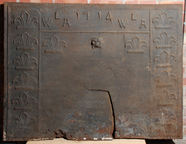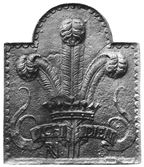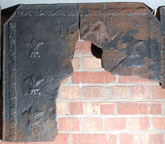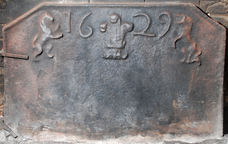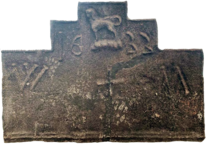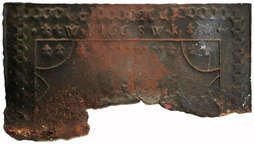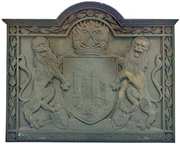-
125
Description: Canted rectangle; twisted rope edging (top and sides); top centre, Tudor royal shield between lion passant guardant to right and lion passant guardant sinister to left, both diagonally placed; below, a crowned rose; to left and right, an 'imp' with arms down, facing left.
Notes: One of a large series incorporating royal heraldic stamps. Canterbury Auction Galleries sale, 29 Nov 2017, lot 939 (£300).
Copies of this fireback are known.
Arms: Tudor royal arms of England
- Decoration tags:
- rectangular with canted top corners (shape)
- rope (edging)
- carved stamps
- heraldic
- armorial
- animals
- humans
Manufactured: in the mid-16th century in the Weald area of England.
Current location: not known.
Citation: Lloyd, N., 1925, 'Domestic Ironwork I', Architectural Review, 58, pp. 58-67.
- Attached to series:
- Royal series
-
223
Description: Rectangular; cavetto with double fillet edging; two side panels each separated by twisted rope, and each containing six fleurs de lys arranged vertically; top panel separated by twisted rope, containing inscription; central panel with lion’s head between two fleurs de lys.
Notes: A late example of the use of individual carved stamps; from Heol Ddu Isaf, Bargoed, acquired by the National Museum of Wales in 1922.
Inscription: WLA [triad] 1714 WLA [triad]
- Decoration tags:
- rectangular (shape)
- carved stamps
- individual letters
- individual numbers
- heraldic
- text
Manufactured: in 1714 possibly in the South Wales area of Wales.
Current location: National History Museum, St Fagans, Glamorgan, Wales.
Museum number: 21.31 (part of the Welsh National History Museum museum group)
- Attached to series:
- Miscellaneous stamp firebacks
- Date & initials firebacks
-
234
Description: Arched rectangular shaped; cavetto moulded edging, scalloped top and sides; Prince of Wales’ badge of three ostrich feathers emerging through a coronet; symmetrical scroll with elaborate swirls, bearing motto; monogrammed initials at bottom, left of centre.
Notes: The scalloped edging and RN monogram have been noted on other firebacks, suggesting a common pattern maker. Formerly from Burwash, Sussex.
Copies of this fireback are known.
Inscription: ICH DIEN / RN
- Decoration tags:
- rectangular with round arch (shape)
- scalloped cavetto (edging)
- whole carved pattern
- heraldic
- monogram
- royal
- text
Manufactured: in the early- to mid-17th century in England.
Current location: National History Museum, St Fagans, Glamorgan, Wales.
Museum number: 20.177/1 (part of the Welsh National History Museum museum group)
- Attached to series:
- RN series
- Prince of Wales firebacks
-
235
Description: Fragment; canted rectangle; twisted rope edging (top and sides); repeated scroll strip stamp along each side; date, top centre; a fleur-de-lys stamp repeated three times vertically down left side, probably mirrored on right side (top fleur visible).
Notes: Use of the same stamps indicates a common source with a variant dated 1692 (see Fireback no. 237).
Inscription: 1694
- Decoration tags:
- rectangular with canted top corners (shape)
- rope (edging)
- simple stamps
- carved stamps
- individual numbers
- heraldic
- text
- objects
Manufactured: in 1694 possibly in the South Wales area of Wales.
Current location: National History Museum, St Fagans, Glamorgan, Wales.
Museum number: 61.49/3 (part of the Welsh National History Museum museum group)
- Attached to series:
- St Fagans series
-
1070
 ? x ? mm
? x ? mmDescription: Rectangular; ovolo-moulded edging; two fleurs-de-lys arranged vertically top left and top right; top centre, date; below date, initials WEI in triad.
Notes: Said to have been made by George White, iron founder, of Monmouth. Formerly from Newport, Monmouthshire.
Inscription: 1668 / W E I [triad]
- Decoration tags:
- rectangular (shape)
- ovolo (edging)
- carved stamps
- individual letters
- individual numbers
- heraldic
- text
Manufactured: in 1668 possibly at Tintern Furnace in the Forest of Dean area of Wales.
Current location: National History Museum, St Fagans, Glamorgan, Wales.
Museum number: 25.21 (part of the Welsh National History Museum museum group)
Citation: Kissack, K., 2003, Monmouth and its Buildings (Almeley, Logaston Press).
- Attached to series:
- Date & initials firebacks
-
244
Description: Canted rectangle; twisted rope edging (top and sides); stamp of three ostrich feathers within a coronet, between the two parts of the date, with lion and unicorn supporters outside date.
Notes: The ostrich feathers are the badge of the Prince of Wales. There is no known significance of the year 1629 with that title, the birth of the prince (later Charles II) being in the following year. The date was probably added to a recasting of the plate. The lack of detail in the modelling indicates this has been recast several times.
Copies of this fireback are known.
Inscription: 16 29
- Decoration tags:
- rectangular with canted top corners (shape)
- rope (edging)
- carved stamps
- individual numbers
- heraldic
- text
- animals
Manufactured: in 1629 in the Weald area of England.
Current location: in private hands, Chailey, East Sussex, England.
Citation: Lloyd, N., 1925, 'Domestic Ironwork I', Architectural Review, 58, pp. 58-67.
- Attached to series:
- Prince of Wales' feathers series
- Prince of Wales firebacks
-
1034
Description: Canted rectangular shape; twisted rope edging in short lengths (top and sides); shield stamp with rebated edges repeated five times (two and three).
Notes: The arms are those of Courthope of Whiligh in Ticehurst; blazon: argent, a fess azure between three estoiles sable (two and one). Shown are molets of six points which have straight rays instead of (properly) estoiles which have wavy ones. However, the 1643/4 iron graveslab of David Barham of Snape, in Wadhurst church, has the same arms (also with molets instead of estoiles), which were those of his mother who was a Courthope.
Arms: Courthope, of Whiligh in Ticehurst
- Decoration tags:
- rectangular with canted top corners (shape)
- rope (edging)
- carved stamps
- heraldic
- armorial
Manufactured: in the late-16th to early-17th century in the Weald area of England.
Current location: Fulham, London, England.
- Attached to series:
- Personal armorial firebacks
- Courthope arms series
-
1255
Description: Rectangular with two-stepped top; twisted rope edging (top and sides), reused frame moulding at bottom; top centre, stamp formed of a talbot statant guardant upon a wreath between separated date; initials formed of straight twisted rope lengths separated between lower shoulders; a cross below the crest.
Notes: Straight elements in the letters and numbers are formed of short lengths of twisted rope; curved elements appear to have been formed by hand drawing in the casting sand; the talbot crest has been seen on other firebacks indicating a common source, and is associated with firebacks with a stepped shape. Chard Auctions, 16 Mar 2023, lot 206 (£85, with two other firebacks).
Inscription: 16 33 / W + M
- Decoration tags:
- stepped (shape)
- rope (edging)
- simple stamps
- carved stamps
- individual letters
- individual numbers
- heraldic
- text
Manufactured: in 1633 in the Weald area of England.
Current location: not known.
- Attached to series:
- Stepped firebacks
- Talbot crest series
-
1155
Description: Rectangular shape; fillet edging (top and sides); across the top, line of squared cross stamps in three groups (5, 5 and 7), with six more continued down each side; below the top line of stamps, central date with initials in triad to each side, interrupting the top line of stamps, with two fleurs-de-lys to each side and a single bead; below, three sides of a rectangular compartment, fillet edged with irregular quadrants at the top corner enclosing two fleurs-de-lys each, between which is a line of about 10 beads between single fleurs.
Notes: A large and badly corroded fireback linking the Square Cross series and Hollow Saltire series stylistically. The initials probably relate to a husband and wife. Chorley's Auctioneers sale, Gloucester, 20 November 2019, lot 634 (£20).
Inscription: WCK [triad] 1668 WCK [triad
- Decoration tags:
- rectangular (shape)
- fillet (edging)
- simple stamps
- carved stamps
- individual letters
- individual numbers
- heraldic
- text
- objects
Manufactured: in 1668 in the Forest of Dean area of England.
Current location: not known.
- Attached to series:
- Newent area group
- Square cross Dean series 1
-
1178
Description: Arched rectangular shape; moulded top edge with undulating floriate border within fillets intersecting at the corners; in each corner a rose; along the bottom, the motto Multi Societate Tutiores - With many more safe; within the border, shield, supporters and crest
Notes: Blazon: Argent, upon a rock issuant from the base proper, inscribed 1824 in gold numerals, a quadrangular castle also proper, pennons flying to the sinister from each tower gules; crest: In front of flames proper issuant from a coronet of four roses argent, barbed and seeded proper, set upon a rim Or, two keys in saltire, wards upwards, sable; supporters: On the dexter side a lion guardant Or, resting the sinister hind leg on an escutcheon argent charged with a rod of Aesculapius gules, and on the sinister side a like lion resting the dexter hind leg on an escutcheon argent charged with an anchor sable. The Alliance Assurance Company was founded in 1824 and merged with the Sun Insurance Company in 1959. The arms were granted in 1933. An openwork version of this fireback (i.e. with the background voided) was formerly displayed outside its offices. Christie's auction, London, sale no.7006, 19 May 2005, lot 34 (£384).
Inscription: MVLTI SOCIETATE TVTIORES
Arms: Alliance Assurance Company
- Decoration tags:
- rectangular with round arch (shape)
- fillet (edging)
- whole carved pattern
- heraldic
- armorial
- text
Manufactured: in the early- to mid-20th century in England.
Current location: not known.
- Attached to series:
- Corporate firebacks

